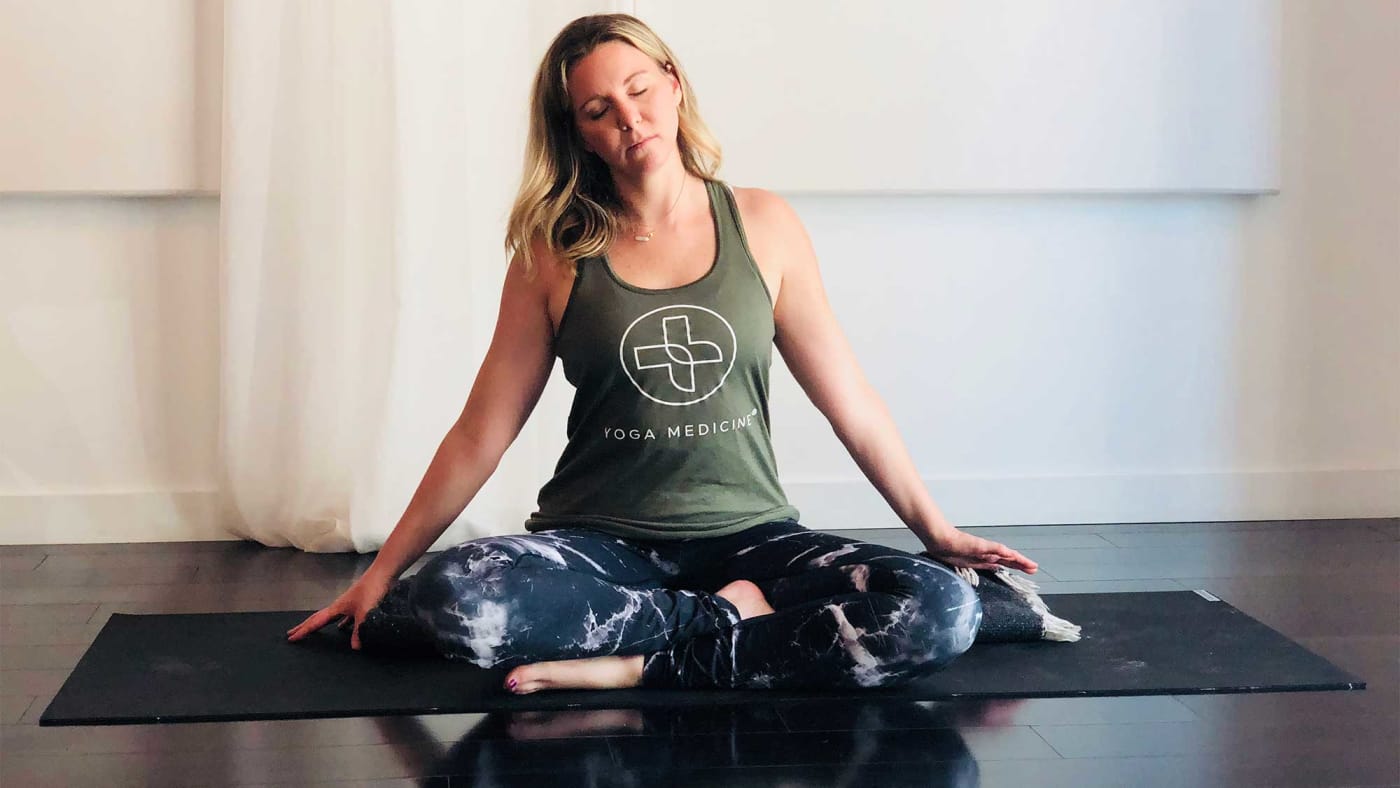Articles, Chinese Medicine, In the Press, Myofascial Release, Resources, Yin, Restorative and Meditation, Yoga Medicine® News
Ready to Let Go? A Yin Yoga Sequence for Fall
Teresa Biggs, AP, DOM for Yoga Journal shares a yin yoga sequence to do this fall. Incorporating slow, restful poses and myofascial release can help let go of the feelings of loss and sadness at this time of year.
Ready to Let Go? A Yin Yoga Sequence for Fall
Fall is a time of transition—and transformation. Here’s a flow to help you handle anything that comes up this season, and release what’s no longer serving you.
Fall is officially in full swing, which means sweater weather, impossibly colorful leaves, and pumpkin-spice everything. In Traditional Chinese Medicine (TCM), however, Fall can also be a time associated with transformation, transition, sadness, and grief—and yoga can be an amazing way to cope with these varied emotions.
Why Fall May Inspire Sadness
In TCM, this time of year correlates to the lung and large intestine channels, which run though the chest and arms and are associated with sadness and grief. These emotions represent our ability to balance taking in and letting go—as is represented in the lungs and large intestine.
The physiological functions of these organs aligns with their energetic function: the lungs govern respiration and the large Intestine governs elimination. Disharmony of both organ systems can present as upper respiratory symptoms (runny nose, cough, hoarse voice, etc.) and constipation. The contraction of energy can present with shallow breath and slow-moving elimination, and if any sadness and grief are not processed, they will continue to constrain qi, or energy—and the emotions will persist.
However, we can use this withdrawing of energy during Fall to our advantage by taking the opportunity to review what needs to be released in our lives. We can bring harmony back to the body by slowing down, giving room for reflection, and creating a state of ease with our relationship to change.
A Yin and Myofascial Release Sequence
As nature and the seasons demonstrate, life is a series of cycles and changes. Through the example of trees, we see the introduction of yin energy as the energy begins to recede, bringing nourishment back within. The leaves change color at this contraction of energy in preparation for winter. The tree, no longer needing the leaves to bring nourishment, are released. The tree lets go.
There can be a sense of loss when this happens in our own lives. The following practice creates space for introspection, stimulates the lung and large intestine channels, and encourages a state of ease. We will use the physical body in our yoga practice to assist the emotional and mental aspects of our being. This sequence can be used anytime you experience loss or need room to create clarity over what is no longer serving you.
A note before you start: When using myofascial release (MFR), there should never be pain. However, there should be sensation. The breath is a good indicator of appropriate amount of sensation for your body. If the breath is restricted, shallow, or you are holding your breath, move the prop slightly (moving the prop even just a few centimeters can change the experience in the tissue) so the breath is more natural and the sensation decreases.
In a Yin practice, we are looking to move into the pose to just 50 to 70 percent of your full capacity for stretch, in order to leave space for the muscles to relax. I have suggested props for the sequence, but feel free to add additional props to support your body as needed. The timed holds can be adjusted to fit your schedule and body. To create an even more introspective practice, add a 1-minute Savasana (Corpse Pose) between poses.
Gentle Chest Opener
We begin with a gentle chest opener to open the lungs and facilitate a deeper breath. When experiencing sadness and grief, the breath can become restricted in the upper part of the lungs, making the breath shallow. Consciously deepening and slowing the breath (use a count of 5 on the inhale and exhale) down-regulates the nervous system, communicating to your body that you are safe. On the inhalation, feel the lungs and ribs expand; then, keep the sensation of expansion on the exhale.
How-to: Fold your blanket into a rectangle shape and roll it length-wise. Adjust the diameter of the blanket to suit your body (recommend 3 inches). Place the rolled blanket perpendicular to your body just below your armpits, so your head can rest comfortably on the floor. Bring your arms into a cactus position, and stay here for 3 minutes.
Neck Release
TCM, transition into Fall can exacerbate any deficiency in the lungs (which governs the immune system), creating room for pathogens to enter the body. Stimulating this area of the neck boosts the body’s resistance. This is also a good tool for headaches.
How-to: Place block on middle height directly underneath your skull, so that the front edge (the edge closest towards your body) of the block is along the occipital ridge. Your neck should be completely off the block; only your skull is heavy on the block. Relax your neck, allowing it to soften, and stay here for 60 seconds. Then, roll your head to the right, bringing your right ear as close as is comfortable to the block. Notice where your nose is pointing. Bring your nose half way back towards center, feeling a ridge of connective tissue, and stay for 60 seconds. Again, notice where your nose is pointing, bring it half way back to center (feeling a second ridge of connective tissue), and stay 60 seconds. Then, bring your head back to center and repeat on left side.
MFR for Armpits and Pectoral Muscles
We stimulate the lung and heart channels through compression of the tissues. Change, sadness, grief, and letting go can also be connected with emotions of the heart. By stimulating these two channels, we encourage these emotions to be processed and released, preventing any stagnation of energy due to suppressing or holding onto emotions.
How-to: Place a block on mid-height directly under your right armpit, perpendicular to your body. Place the center of your armpit on the center of the block, so the upper edge of the block is in contact with your tricep and your elbow can rest on the ground. Rest your head in your right hand, and allow the right side body to sink towards the ground, letting the tissues of your armpit soften. Stay here for 1-3 minutes. Then, keeping the block where it is, simply roll forward to compress the pectoral muscle. Rest your left forearm on the ground to support the upper body. If it is comfortable, rest your forehead on your hands. Stay here for 1-3 minutes, then repeat on left side.
Pectoral Release
Now, we’ll continue to stimulate the lung channel to encourage smooth breathing and a state of openness and ease. If an emotional response occurs, allow the emotions to be released without attachment. Maintain slow, deep breathing.
How-to: Begin face down on your abdomen. Extend your right arm to the right side, perpendicular to your body (in a T-shape). Turn your head to the left, resting on your right side. Bring your left hand even with your left shoulder and press into left hand to open your torso. Keep the left hand in front of your body to support your weight as you bend your knees toward your chest. Gently point your chin toward your chest. Stay here for 3 minutes, then repeat on the other side.
Pectoral Release Modification
If your body can go deeper, keep the upper body the same as you extend your legs straight. Bend the knee of the top leg and place the foot behind your bottom leg, using the weight of the lower body to deepen the sensation on the right side chest. Keep your chin gently pointing toward your chest.
Digestion Reboot
When we are resistant to letting go, we can hold onto our “stuff” physically, becoming constipated. This posture helps to address any digestion and elimination stagnation that can occur with imbalance in the large intestine.
How-to: Take the rolled blanket (about 3-5 inches in diameter) and place it perpendicular to your body, directly under your navel. Bring your forearms to the ground to support the upper body. Depending on the level of pressure that’s comfortable for you, you can bring your entire abdomen to the floor, resting your forehead on your hands. On an inhalation, press your belly into the blanket. On an exhalation, allow the belly to hollow out, letting the blanket roll sink into your abdomen. Continue this breath pattern for 1-2 minutes. Note: Don’t do this if you’re pregnant or recently had abdominal surgery.
Heart Melting Pose
We use the energy of this pose to allow anything we need to let go of to melt off the heart and body. As that happens, honor what is released with a sense of compassion. As we let go, we create space for growth and evolution, and align with the cycles of nature.
How-to: From your hands and knees, walk your hands toward the top of your mat, extending your arms overhead as your drop your forehead and chest to the ground, keeping your hips above knees. Stay here for 3-5 minutes.
Heart Melting Pose Modification
If your body is open to go deeper, bend your elbows to bring your hands in Anjali mudra (Prayer Pose) behind your head.
Child’s Pose
In this posture, we move into a place of respite. We will use Child’s Pose to create rest and relief physically, emotionally, and mentally. Allow your breath to be natural.
How-to: From Tabletop position, sit your hips back to your heels and rest your arms alongside your body. Bring your knees as close to each other or as far apart to create the most comfort for your body. Drop your forehead to the ground or a prop, and place a blanket under your hips if that helps you relax more fully. Stay here for 3 minutes.
Trap Release
As we face changes in life and when we let things go, we may encounter resistance. This posture addresses the most common area of the body to hold tension and stress: the trapezius muscles.
How-to: Come into an easy seat, bringing your right shin in front of your left. Place a blanket under your hips to support pelvic alignment. Interlace your fingers behind your back and bring your interlaced hands to your right hip. Drop your right ear towards the right shoulder, and stay here for 3 minutes. Then, repeat on left side, bringing your left shin in front of your right.
Trap Release Modification
If this does not feel comfortable in your shoulders, bring your right hand off to the right side so it’s even with your hip, and bring your left arm along the left side body (it will float off ground) as you drop your right ear to your right shoulder.
Straddle Pose
In this posture, we nourish the Earth element, which is active during the transition of seasons. By stimulating the inner legs (the channels of Earth element), we strengthen the element that helps us during transitions. Holding this pose also helps us to create space for introspection, allowing ourselves to be present with any emotions.
How-to: From a seated position, spread your legs as wide as comfortable. Keep a blanket under your hips to encourage a forward pelvic tilt (so your sit bones point behind you). Lift your spine out of your pelvis as you reach your sternum towards the front wall. Once you reach your desired sensation, support yourself with your arms on the ground or a prop and fully relax your neck. Stay here for 3-5 minutes.
Simple Supine Twist with Acupressure
Along with a gentle, detoxing twist, we stimulate our defensive Qi with the Stomach 36 acupressure point. Stomach 36 is located 4-fingers width below the knee, just lateral to the shin bone. Press this point (acupressure works best if held for minutes rather than seconds) anytime to increase vitality of the body.
How-to: Lay on your back and hug your knees toward your chest. Drop your knees to the right and place a block between your knees. Allow the back of your skull to rest heavy on the ground. Extend your left arm straight out to side and bring your right hand to touch the Stomach 36 acupressure point on your top (right) leg and massage it gently. Stay here for 3-5 minutes, then repeat on the left side.
Supported Supta Baddha Konasana
To finish this practice, we transition into a pose that invites openness so that as we move forward with clarity, we are open to change with an open mind and heart.
How-to: Lay on your back with your knees bent, feet on the ground. Take the long, rolled blanket and wrap it around the front of your ankles. Then, take the tail ends of the blanket and place them under your hips as you open your knees. Place one hand on your heart and the other on your abdomen. Feel the support of this pose as you observe your breath, feeling your lungs expand on the slow inhale and your abdomen dropping toward your spine on the slow exhale. On each inhalation, silently breath in the word “let.” On each exhalation, silently breath out the word “go.” Stay here for 3-5 minutes.



























